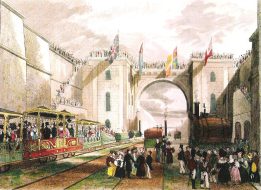
This week saw the Mayors of Greater Manchester and Liverpool meet at Rainhill Station to announce that they will create a Liverpool-Manchester Railway Board revealing that the Government has backed moves to examine options to bolster the corridor between Liverpool and Manchester.
We go back in time 200 years to the first building of the link and the obstacles and challenges that were thrown up as Stephenson battled to build the link between the two cities
One major obstacle was Chat Moss with one committee member telling the railway pioneer,
“It rises in height from the rain swelling it like a sponge, and sinks again in dry weather; and if a boring instrument is put into it, it sinks immediately by its own weight. The making of an embankment out of this pulpy wet moss is no very easy task. Who but Mr. Stephenson would have thought of entering into Chat Moss, carrying it out almost like wet dung? It is ignorance almost inconceivable. It is perfect madness”
However Stephenson would not be beaten, deciding to transverse it using a floating raft to support the four mile track bed across the bog.At first a footpath of heather was laid along the proposed route.
This worked well and so it was broadened out to carry a contractor’s line on which boys pushed the one ton wagons of construction material.Over two hundred men were employed to lay drains on each side of the track area.
The problems would not go away and whilst this worked on the shallower parts, it made no little or impact on the deeper areas of the bog, forcing Stephenson to change his plan, replacing the drain with barrels and casks jointed together and coated with clay to create a form of pipe.
His critics suggested that he should abandon his strategy and instead build a viaduct across the bog but he refused.Instead so the story goes one of the men on the site, Robert Stannard, suggested laying timber in herring-bone fashion. This was combined with moss, heather and brushwood hurdles and the track was completed.
Other obstacles stood in the way.The Sankey valley,spanned by a viaduct built at the cost of forty five thousand pounds and the Clive Cutting as the line approaches Liverpool, the first of its kind in the country and still being used to this day
Famously tragedy would strike on its opening day as as the MP William Huskisson knocked down and killed at Parkside station whilst the Duke of Wellington, Sir Robert Peel and Prince Esterhazy looked on.
as the MP William Huskisson knocked down and killed at Parkside station whilst the Duke of Wellington, Sir Robert Peel and Prince Esterhazy looked on.
But it would quickly prove a success and would bring tourists flocking to the town to see this new wonder
.Amongst them, Richard Harding,originally from the West Country, later to become a Wesleyan minister, shortly to travel to Jamaica where he was to spend the rest of his life, looking after the interests of the newly emancipated Negroes.
His words echo the wonder of this new fangled mode of communication.Like a child in a toy factory he describes how the railway is carried over the Irwell at a great height, “reaching the elevation of some of the great houses” and of its beginnings
“in order to take the carriages you ascend a double flight of stairs which leads out of the office to the railway….the passengers being all seated,they move off slowly reaching full speed in about a minute which is one mile in two minutes….the noise is great and rather disagreeable…the smoke and steam carried back from the engine over the carriages…although as the carriages were covered,the passengers are protected from it.”
However he adds that “such is the quantity of steam that you seem to be immersed in a cloud and there is a continual dropping from the front as though it were raining on it
The railway, ”is certainly one of the wonders of art and such a stupendous work that you wonder at man’s undertaking of it. “
With its opening, the canals would soon be superseded,,goods brought to Manchester from the docks at Liverpool at eighteen miles an hour, cutting the journey by half between the two towns using locomotive engines first tested in the coalfields of Newcastle.
Seven years later, the line would be connected to Birmingham and the railway age was born, before long the country was connected and things would never be the same again.People who had once been born, grown up and died within a few miles of their birthplace could now move around freely.
Social and regional barriers would break down,the ages of leisure and mass communications would begin.Perishable foods could be transported around the country, fresh fish could be eaten in Manchester and as transportation costs fell, the age of mass consumerism would arrive.
What then will a new link bring to the region two hundred years on?






